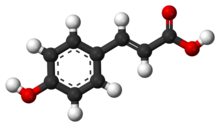p-Coumaric acid is an organic compound with the formula HOC6H4CH=CHCO2H. It is one of the three isomers of hydroxycinnamic acid. It is a white solid that is only slightly soluble in water but very soluble in ethanol and diethyl ether.
 | |
 | |
| Names | |
|---|---|
| Preferred IUPAC name
(2E)-3-(4-Hydroxyphenyl)prop-2-enoic acid | |
| Other names
(E)-3-(4-Hydroxyphenyl)-2-propenoic acid (E)-3-(4-Hydroxyphenyl)acrylic acid para-Coumaric acid 4-Hydroxycinnamic acid β-(4-Hydroxyphenyl)acrylic acid | |
| Identifiers | |
3D model (JSmol) |
|
| 2207383 | |
| ChEBI | |
| ChEMBL | |
| ChemSpider | |
| DrugBank | |
| ECHA InfoCard | 100.116.210 |
| EC Number |
|
| 2245630 | |
| KEGG | |
PubChem CID |
|
| UNII | |
CompTox Dashboard (EPA) |
|
| |
| |
| Properties | |
| C9H8O3 | |
| Molar mass | 164.160 g·mol−1 |
| Melting point | 210 to 213 °C (410 to 415 °F; 483 to 486 K) |
| Hazards | |
| GHS labelling: | |
   | |
| Danger | |
| H301, H302, H311, H314, H315, H317, H319, H335 | |
| P260, P261, P264, P270, P271, P272, P280, P301+P310, P301+P312, P301+P330+P331, P302+P352, P303+P361+P353, P304+P340, P305+P351+P338, P310, P312, P321, P322, P330, P332+P313, P333+P313, P337+P313, P361, P362, P363, P403+P233, P405, P501 | |
Except where otherwise noted, data are given for materials in their standard state (at 25 °C [77 °F], 100 kPa).
| |
Natural occurrences
It is a precursor to many natural products, especially lignols, precursors to the woody mass that comprise many plants.[1] Of the myriad occurrences, p-coumaric acid can be found in Gnetum cleistostachyum.[2]
In food
p-Coumaric acid can be found in a wide variety of edible plants and fungi such as peanuts, navy beans, tomatoes, carrots, basil and garlic.[citation needed] It is found in wine and vinegar.[3] It is also found in barley grain.[4]
Derivatives
p-Coumaric acid glucoside can also be found in commercial breads containing flaxseed.[6] Diesters of p-coumaric acid can be found in carnauba wax.
Biosynthesis
It is biosynthesized from cinnamic acid by the action of the P450-dependent enzyme 4-cinnamic acid hydroxylase (C4H).
It is also produced from L-tyrosine by the action of tyrosine ammonia lyase (TAL).
Biosynthetic building block
p-Coumaric acid is the precursor of 4-ethylphenol produced by the yeast Brettanomyces in wine. The enzyme cinnamate decarboxylase catalyzes the conversion of p-coumaric acid into 4-vinylphenol.[7] Vinyl phenol reductase then catalyzes the reduction of 4-vinylphenol to 4-ethylphenol. Coumaric acid is sometimes added to microbiological media, enabling the positive identification of Brettanomyces by smell.
cis-p-Coumarate glucosyltransferase is an enzyme that uses uridine diphosphate glucose and cis-p-coumarate to produce 4′-O-β-D-glucosyl-cis-p-coumarate and uridine diphosphate (UDP). This enzyme belongs to the family of glycosyltransferases, specifically the hexosyltransferases.[8]
Phloretic acid, found in the rumen of sheep fed with dried grass, is produced by hydrogenation of the 2-propenoic side chain of p-coumaric acid.[9]
The enzyme, resveratrol synthase, also known as stilbene synthase, catalyzes the synthesis of resveratrol ultimately from a tetraketide derived from 4-coumaroyl CoA.[10]
p-Coumaric acid is a cofactor of photoactive yellow proteins (PYP), a homologous group of proteins found in many eubacteria.[11]
See also
References
Wikiwand in your browser!
Seamless Wikipedia browsing. On steroids.
Every time you click a link to Wikipedia, Wiktionary or Wikiquote in your browser's search results, it will show the modern Wikiwand interface.
Wikiwand extension is a five stars, simple, with minimum permission required to keep your browsing private, safe and transparent.






